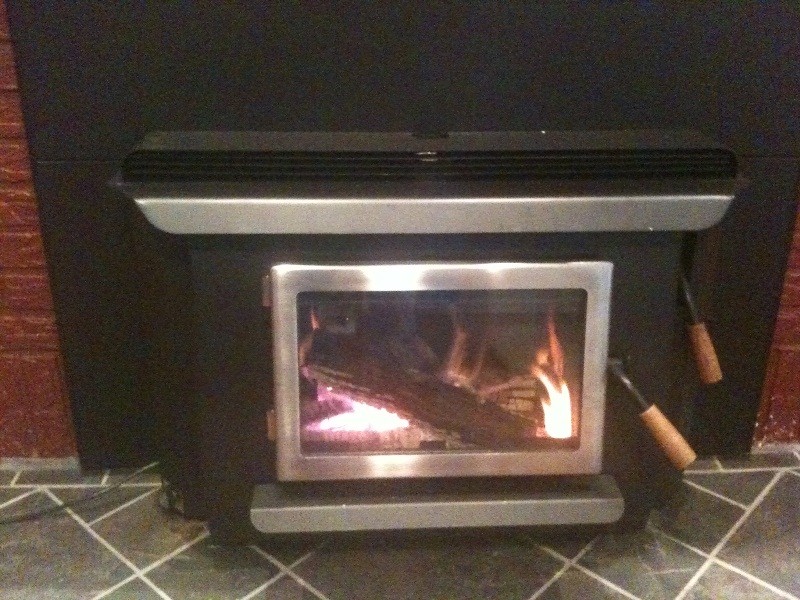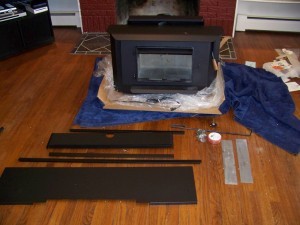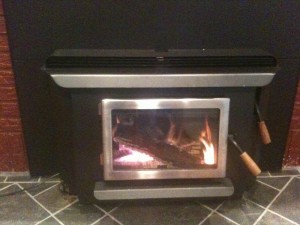Now I would like to say we created the perfect Fireplace Guide, but I know we didn’t. There truly is a lot to fireplaces. We didn’t want to cover everything, because that would be a website in its own. We did want to cover some of the most common terms, questions and information, which we will do in this guide. However, we are not going to get into things such as figuring out efficiency when you have “X” BTU and a home from the 50’s that lets in “X” amount of air, what fireplace should I get? We want to create a guide of the most common items we had to deal with when we did our fireplace install project. These are all things you will hear about or read when you start your project. Even if you are going to hire someone, we would still recommend reading this guide. The first thing I learned was how many terms people, including myself, use interchangeably. So we need to start by discussing Fireplace Terms or definitions.
Wood Burning Fireplace Terms
BTU (British Thermal Unit) – The standard heat measurement unit used by the fireplace industry. One BTU is the amount of heat required to raise the temperature of 1 lb of water by 1°F at sea level.
Catalytic Combustor – A device used on some wood burning stoves to reduce the temperature at which smoke is ignited.
Catalytic Wood Stove – Catalytic wood stoves and fireplace inserts have ceramic honeycomb chambers coated with a metal catalyst (usually platinum or palladium) that works to increase the rate of combustion. The catalytic combustor burns away gases and particles normally emitted into the air. Catalytic wood stoves and inserts allow for wood to be burned at lower temperatures for longer periods of time. Also see Non-Catalytic.
Clearance – The distance required by building and fire codes between a stove, smoke pipe or chimney and combustible materials such as wood furniture or carpets. Clearances must be observed even if noncombustible plaster or other masonry materials protect the combustible materials (such as wood furniture or carpets).
Creosote – Carbon material that accumulates in chimneys from wood burning fires. If it glazes on the firebrick in the chimney it can cause a flue fire.
Damper – A metal device inside the fireplace chimney used to reduce or close the opening between the firebox and flue; stops cold chimney drafts.
Downdraft – A strong, downward current of air.
Firebox – Portion of a solid fuel appliance where fuel (such as wood) is located and combusted.
Flue – Pipe that moves the smoke from the fireplace to the chimney and outside.
Hearth – The floor of the firebox, most commonly used in reference to fireplaces. More generally, the foundation upon which fires for aesthetic and heating purposes are built. Differs from floor protection.
High Efficiency – EPA-approved fireplaces offering a balance of aesthetics and energy efficiency.
Insert – Heating units that will fit into an existing fireplace (masonry or factory-built). They burn wood, gas, or pellets and are generally used to increase the efficiency or change the look and feel of an existing fireplace.
Non-Catalytic Wood Stove – Combustion occurs inside the firebox. Non-catalytic wood stoves are generally less expensive than catalytic wood stoves and require less maintenance.
Unvented, Ventless or Vent Free – Term used to relate to either a low BTU gas log or a gel fueled fireplace that does not require a flue or chimney for ventilation.
Vent – Exhaust duct for wood or gas fireplaces.
B Vent – A system that doesn’t have a sealed combustion chamber and relies on hot gases to rise and escape.
Direct Vent – It has a chimney that can vent horizontally or vertically to the roof using a double wall flue. It has a completely enclosed firebox with a pane of glass that cannot be removed. It draws air for combustion through a double wall flue and expels gases to the outside as well.
Two Common Types of Fireplaces
Free Standing (Stove) – A free standing wood burner is also called a stove. The idea behind this is that it radiates heat. You can install this almost anywhere in your house. The vent gets piped through the wall or ceiling. Check manufacturers directions before installing.
Insert – An insert sits in your fireplace and is vented through a liner that goes into your flue. An insert uses a blower to move heat into your home as opposed to radiated heat.
Fuel Types
There are three main types of materials you can burn in a fireplace.
Wood – Obviously this is a tree that is cut up to a certain size. Usually between 13″ and 21″ in length. Just make sure you are using wood that is dried out. You want to use only wood with a max moisture content of 20%. This will burn hotter, more efficient and cause less creosote to build up.
Pellets – You can buy small pellets in a bag. Much cleaner to work with and easier to store.
Gas – Some fireplaces burn gas. Natural gas or propane gas.
Electric – You guessed it. This one is powered by electricity.
Wood Burning Fireplace Question and Answers
Can I burn scrap wood from a project such as 2×4’s in my fireplace?
- No. Only use seasoned wood in your fireplace. Certain wood for construction may have chemicals which can ruin your combustor. Plywood also has glue that can damage your combustor.
Do I need to have my fireplace professionally installed?
- It is highly recommended that a professional install your wood burning stove or fireplace.
How do I know if my Fireplace is operating normally?
- Take a visual. Look at the smoke coming out of your chimney. If it is white, then you are good. This means you have basically steam or the white evaporation left. If the color is darker, then you still have unburnt fuel that is escaping.
Do I still need to clean my liner if my stove is very efficient?
- Yes, you still need to have someone inspect your liner once a year for safety reasons.
How often should I have my fireplace and liner inspected?
- It is recommended you have your system inspected at least once a year.
Do I have to use seasoned wood in my fireplace?
- Yes. You should never burn green wood or wood that is still wet. Wet wood is not efficient and causes more creosote build up which can cause fires inside your liner.
Like we said there is a lot more to fireplaces. We wanted to make a nice overview of some of the terms you will encounter and also some of the questions you might have or atleast questions we had. If we have forgotten to include anything that is helpful, please let us know.




